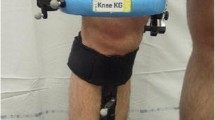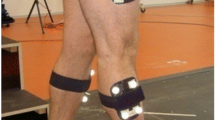Abstract
Background
Anterior cruciate ligament (ACL) rupture is one of the most common injuries associated with the knee. After ACL injury, knee joint stability can be altered, resulting in abnormal loading during functional activities. Since ACL-deficient (ACLD) knees are also vulnerable to translational and rotational instability, patients need to be wary of certain motions encountered in daily life. The present study investigated the effect of walking speed and pivoting directional change during gait on knee joint kinematics of ACLD knees. We hypothesized that faster walking and crossover turning would induce severe kinematic changes.
Methods
Thirty-five patients (22 males and 13 females) having a unilateral isolated subacute ACLD knee (from 1 to 3 months after injury) and contralateral intact (CLI) knee participated in this study. Spatiotemporal parameters, three-dimensional (3D) knee joint angles, and anterior-posterior (AP) translation were obtained by a 3D high-speed motion-capturing system. The CLI knee of each patient served as the control. The calculated AP stability and knee joint angles were used to test the research hypothesis. Mixed two-way repeated measures analysis of variance was performed to clarify the effects of walking speed and pivoting direction with a significance of 0.05. When a significance of mean comparison was detected, a post hoc test was performed.
Results
Significant and consistent increased AP translation of the tibia relative to the femur at the whole stance phase of the gait cycle was evident in ACLD knees compared to CLI knees for normal and faster (20 % greater than normal) walking speeds. Faster walking speed did not induce significantly more anterior location of the tibia. In addition, ACLD knees were significantly less extended than CLI knees during a large portion of midstance. Although there was a consistent varus offset between the curves of ACLD and CLI knees, the difference did not reach statistical significance during the stance phase. Also, ACLD knees did not show any significant difference in tibial rotation compared to CLI knees during the entire stance phase of the gait cycle. For pivoting turns, ACLD knees showed significantly less extended and varus offset than CLI knees only during the cutting turn. ACLD knees exhibited less tibial internal rotation during the crossover turn and less tibial external rotation during the cutting turn than CLI knees.
Conclusions
In ACLD knees, the tibia tended to shift more anteriorly and changed with less extension at walking. However, faster walking speed did not induce any significant difference compared with normal-speed walking. In addition, ACLD knees displayed kinematic changes during pivoting, but not the crossover turn.





Similar content being viewed by others
References
Bulgheroni P, Bulgheroni MV, Andrini L, Guffanti P, Giughello A. Gait patterns after anterior cruciate ligament reconstruction. Knee Surg Sports Traumatol Arthrosc. 1997;5(1):14–21.
Schultz RA, Miller DC, Kerr CS, Micheli L. Mechanoreceptors in human cruciate ligaments. A histological study. J Bone Jt Surg Am. 1984;66(7):1072–6.
Andersen HN, Dyhre-Poulsen P. The anterior cruciate ligament does play a role in controlling axial rotation in the knee. Knee Surg Sports Traumatol Arthrosc. 1997;5(3):145–9.
Markolf KL, Burchfield DM, Shapiro MM, Shepard MF, Finerman GA, Slauterbeck JL. Combined knee loading states that generate high anterior cruciate ligament forces. J Orthop Res. 1995;13(6):930–5.
Ingersoll CD, Grindstaff TL, Pietrosimone BG, Hart JM. Neuromuscular consequences of anterior cruciate ligament injury. Clin Sports Med. 2008;27(3):383–404 vii.
Baliunas AJ, Hurwitz DE, Ryals AB, Karrar A, Case JP, Block JA, Andriacchi TP. Increased knee joint loads during walking are present in subjects with knee osteoarthritis. Osteoarthr Cartil. 2002;10(7):573–9.
Brandt KD, Myers SL, Burr D, Albrecht M. Osteoarthritic changes in canine articular cartilage, subchondral bone, and synovium fifty-four months after transection of the anterior cruciate ligament. Arthritis Rheum. 1991;34(12):1560–70.
Andriacchi TP, Briant PL, Bevill SL, Koo S. Rotational changes at the knee after ACL injury cause cartilage thinning. Clin Orthop Relat Res. 2006;442:39–44.
Chaudhari AM, Briant PL, Bevill SL, Koo S, Andriacchi TP. Knee kinematics, cartilage morphology, and osteoarthritis after ACL injury. Med Sci Sports Exerc. 2008;40(2):215–22.
Andriacchi TP, Dyrby CO. Interactions between kinematics and loading during walking for the normal and ACL deficient knee. J Biomech. 2005;38(2):293–8.
Chen CH, Li JS, Hosseini A, Gadikota HR, Gill TJ, Li G. Anteroposterior stability of the knee during the stance phase of gait after anterior cruciate ligament deficiency. Gait Posture. 2012;35(3):467–71.
Gao B, Zheng NN. Alterations in three-dimensional joint kinematics of anterior cruciate ligament-deficient and -reconstructed knees during walking. Clin Biomech (Bristol, Avon). 2010;25(3):222–9.
Georgoulis AD, Papadonikolakis A, Papageorgiou CD, Mitsou A, Stergiou N. Three-dimensional tibiofemoral kinematics of the anterior cruciate ligament-deficient and reconstructed knee during walking. Am J Sports Med. 2003;31(1):75–9.
Wang H, Fleischli JE, Nigel Zheng N. Effect of lower limb dominance on knee joint kinematics after anterior cruciate ligament reconstruction. Clin Biomech (Bristol, Avon). 2012;27(2):170–5.
Fuentes A, Hagemeister N, Ranger P, Heron T, de Guise JA. Gait adaptation in chronic anterior cruciate ligament-deficient patients: Pivot-shift avoidance gait. Clin Biomech (Bristol, Avon). 2011;26(2):181–7.
Gao B, Cordova ML, Zheng NN. Three-dimensional joint kinematics of ACL-deficient and ACL-reconstructed knees during stair ascent and descent. Hum Mov Sci. 2012;31(1):222–35.
Waite JC, Beard DJ, Dodd CA, Murray DW, Gill HS. In vivo kinematics of the ACL-deficient limb during running and cutting. Knee Surg Sports Traumatol Arthrosc. 2005;13(5):377–84.
Zhu H, Wertsch JJ, Harris GF, Alba HM. Walking cadence effect on plantar pressures. Arch Phys Med Rehabil. 1995;76(11):1000–5.
Hagemeister N, Parent G, Van de Putte M, St-Onge N, Duval N, de Guise J. A reproducible method for studying three-dimensional knee kinematics. J Biomech. 2005;38(9):1926–31.
Grood ES, Suntay WJ. A joint coordinate system for the clinical description of three-dimensional motions: application to the knee. J Biomech Eng. 1983;105(2):136–44.
Cohen HS, Sangi-Haghpeykar H. Walking speed and vestibular disorders in a path integration task. Gait Posture. 2011;33(2):211–3.
Fetto JF, Marshall JL. Injury to the anterior cruciate ligament producing the pivot-shift sign. J Bone Jt Surg Am. 1979;61(5):710–4.
Knoll Z, Kocsis L, Kiss RM. Gait patterns before and after anterior cruciate ligament reconstruction. Knee Surg Sports Traumatol Arthrosc. 2004;12(1):7–14.
Seon JK, Song EK, Park SJ. Osteoarthritis after anterior cruciate ligament reconstruction using a patellar tendon autograft. Int Orthop. 2006;30(2):94–8.
Czerniecki JM, Lippert F, Olerud JE. A biomechanical evaluation of tibiofemoral rotation in anterior cruciate deficient knees during walking and running. Am J Sports Med. 1988;16(4):327–31.
Ramsey DK, Lamontagne M, Wretenberg PF, Valentin A, Engstrom B, Nemeth G. Assessment of functional knee bracing: an in vivo three-dimensional kinematic analysis of the anterior cruciate deficient knee. Clin Biomech (Bristol, Avon). 2001;16(1):61–70.
Kozanek M, Van de Velde SK, Gill TJ, Li G. The contralateral knee joint in cruciate ligament deficiency. Am J Sports Med. 2008;36(11):2151–7.
Acknowledgments
The authors thank Young-ju Jeong and Haeng-nan Cho for their study assistance at the Gait Laboratory of the Chonnam National University Hospital.
Conflict of interest
None of the authors received, or will receive, any benefits or funding from any commercial party related directly or indirectly to the subject of this article.
Author information
Authors and Affiliations
Corresponding author
About this article
Cite this article
Yim, J.H., Seon, J.K., Kim, Y.K. et al. Anterior translation and rotational stability of anterior cruciate ligament-deficient knees during walking: speed and turning direction. J Orthop Sci 20, 155–162 (2015). https://doi.org/10.1007/s00776-014-0672-6
Received:
Accepted:
Published:
Issue Date:
DOI: https://doi.org/10.1007/s00776-014-0672-6




